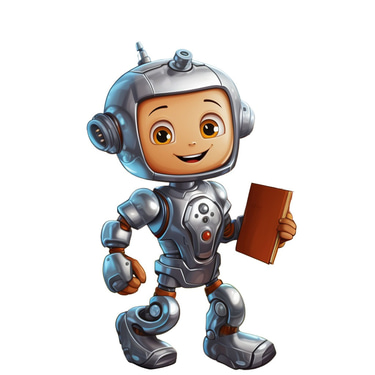Step-by-Step Guide to Using ChatGPT-EDU for Education
6/5/20247 min read


Introduction to ChatGPT-EDU
ChatGPT-EDU is a specialized iteration of OpenAI's versatile language model, specifically designed to cater to the unique demands of the educational sector. Unlike the general ChatGPT model, ChatGPT-EDU is finely tuned to deliver tailored responses that address academic queries with greater precision and relevance. This customization ensures that the model can provide meaningful assistance in various educational contexts, ranging from K-12 classrooms to higher education institutions.
One of the key differentiators of ChatGPT-EDU is its enhanced safety measures. Recognizing the sensitive nature of educational environments, OpenAI has implemented robust safeguards to minimize the risk of inappropriate or harmful content. These safety protocols are particularly crucial in protecting younger users while fostering a secure learning atmosphere.
Furthermore, ChatGPT-EDU comes equipped with a suite of tools designed to support both educators and students. For educators, the model offers functionalities that streamline lesson planning, generate educational content, and assist in grading. On the student side, ChatGPT-EDU aids in research, problem-solving, and offers personalized tutoring, helping to bridge gaps in understanding and promote independent learning.
The integration of ChatGPT-EDU into educational settings holds significant promise. For K-12 education, it can serve as an invaluable resource for teachers, aiding in the creation of engaging lesson plans and providing real-time support for student inquiries. In higher education, ChatGPT-EDU can assist with complex research queries, facilitate collaborative projects, and offer personalized learning experiences that cater to diverse academic needs.
Overall, ChatGPT-EDU stands as a transformative tool in the educational landscape, leveraging advanced AI capabilities to enhance teaching and learning outcomes. Its specialized features and robust safety measures make it a trusted ally for educators and a reliable resource for students, paving the way for a more interactive and effective educational experience.
Setting Up ChatGPT-EDU
Setting up ChatGPT-EDU for educational purposes is a straightforward process designed to cater to diverse educational environments, including individual classrooms, school-wide deployments, and remote learning scenarios. Follow these step-by-step instructions to ensure a smooth setup.
First, begin by creating an account on the ChatGPT-EDU platform. Visit the official ChatGPT-EDU website and click on the "Sign Up" button. Fill in the required details such as your name, email address, and a secure password. Once you've completed the registration form, you will receive a verification email. Click on the verification link to activate your account.
After verifying your account, you will need to choose a subscription plan that best suits your educational needs. ChatGPT-EDU offers various subscription options, ranging from free basic plans for individual use to comprehensive packages for entire schools or districts. Evaluate the features and benefits of each plan to make an informed decision. Once you've selected a subscription, proceed to the payment section to finalize your subscription.
Upon successful subscription, you can access the platform's dashboard. Here, you will find options to configure user settings tailored to your specific educational environment. For individual classroom use, you can set up teacher and student accounts, customize user permissions, and allocate resources. For school-wide deployment, create administrative accounts to manage multiple classrooms and monitor usage across the institution. In remote learning scenarios, ensure that the platform is accessible to all students by configuring necessary remote access settings.
To optimize the initial setup, consider the following tips. For teachers, familiarize yourself with the platform's features and tools by exploring tutorials and guides available on the dashboard. Customizing the interface to match your teaching style can enhance the learning experience. For students, provide clear instructions on how to access and use ChatGPT-EDU, and offer introductory sessions to help them navigate the platform efficiently.
By following these steps, you can effectively set up ChatGPT-EDU, ensuring a seamless integration into your educational framework and maximizing the benefits for both teachers and students.
Integrating ChatGPT-EDU into Curriculum
Integrating ChatGPT-EDU into the educational curriculum can revolutionize the way students learn and teachers instruct. By leveraging the capabilities of this advanced AI, educators can create more dynamic and personalized learning experiences. One effective strategy is to use ChatGPT-EDU as a supplemental tutoring tool. For instance, in subjects like mathematics and science, ChatGPT-EDU can provide step-by-step explanations of complex problems, ensuring students grasp foundational concepts before moving forward.
In language arts, ChatGPT-EDU can assist students with writing assignments by offering suggestions for improvement, grammar checks, and even brainstorming ideas. Teachers can use the AI to conduct interactive reading comprehension exercises, where ChatGPT-EDU poses questions about a text and provides immediate feedback on students’ responses. This not only reinforces understanding but also keeps students engaged by making the learning process interactive.
Social studies classes can benefit from ChatGPT-EDU’s vast informational database. Educators can create lesson plans that include AI-facilitated discussions on historical events, helping students to explore different perspectives and understand the significance of these events in a broader context. Additionally, ChatGPT-EDU can simulate debates on social issues, encouraging critical thinking and enhancing students’ ability to articulate and defend their viewpoints.
For STEM subjects, ChatGPT-EDU can be integrated into lab exercises and projects. The AI can guide students through experimental procedures, answer technical questions, and provide instant feedback on data analysis, making the learning experience more interactive and less intimidating. This hands-on approach helps to solidify theoretical knowledge through practical application.
Creating lesson plans that harness ChatGPT-EDU involves identifying key learning objectives and determining how the AI can support these goals. For example, a lesson plan on renewable energy could include a segment where ChatGPT-EDU explains different types of renewable resources, followed by a Q&A session where students can ask the AI specific questions. This not only enhances understanding but also promotes active learning.
By thoughtfully integrating ChatGPT-EDU into the curriculum, educators can create a more engaging, personalized, and effective learning environment. This innovative approach can help foster a deeper understanding of various subjects and prepare students for future academic and professional success.
Enhancing Student-Teacher Interaction with ChatGPT-EDU
ChatGPT-EDU presents a transformative approach to fostering better communication and interaction between students and teachers. By integrating this advanced educational tool into the classroom, educators can facilitate more dynamic and responsive learning environments. One of the primary applications of ChatGPT-EDU is in hosting interactive Q&A sessions. Teachers can leverage the platform to address student inquiries in real-time, ensuring that no question goes unanswered. This immediate access to information empowers students to engage more actively with the material and fosters a culture of curiosity.
Additionally, ChatGPT-EDU can provide instant feedback on assignments, a critical component for reinforcing learning. Timely feedback helps students understand their mistakes and areas of improvement promptly, thus enabling them to correct their course before misconceptions are cemented. This aspect of ChatGPT-EDU is particularly beneficial in promoting self-paced learning, where students can revisit concepts and refine their understanding based on the feedback received.
Differentiated instruction is another significant advantage offered by ChatGPT-EDU. Teachers can customize the platform to cater to the diverse learning needs of their students. Whether it's providing additional resources for advanced learners or simplifying complex topics for those who need extra support, ChatGPT-EDU ensures that each student receives personalized attention. This tailored approach helps in addressing the unique challenges faced by individual students, making learning more inclusive and effective.
Moreover, ChatGPT-EDU aids teachers in monitoring student progress meticulously. The platform's analytical capabilities allow educators to track performance trends and identify areas where students might be struggling. By having a clear overview of each student's journey, teachers can intervene early and provide the necessary support to prevent any learning gaps. This proactive approach not only enhances student performance but also builds a robust teacher-student rapport.
In essence, ChatGPT-EDU is a versatile tool that significantly enhances student-teacher interaction. By facilitating Q&A sessions, providing instant feedback, supporting differentiated instruction, and enabling detailed progress monitoring, it creates an enriched educational experience. This dynamic interaction fosters a more engaged and responsive classroom, ultimately leading to better educational outcomes.
Ensuring Safe and Ethical Use of ChatGPT-EDU
Safety and ethics are crucial aspects to consider when integrating AI tools like ChatGPT-EDU into educational environments. This advanced AI platform is designed with several built-in safety features to protect students and ensure responsible utilization. One of the primary safety mechanisms in ChatGPT-EDU is its robust content moderation system. This system actively filters and monitors interactions to prevent the dissemination of inappropriate or harmful content, ensuring a secure and conducive learning atmosphere for students.
Privacy settings are another critical feature of ChatGPT-EDU, emphasizing the protection of student data. The platform adheres to stringent privacy policies, ensuring that any data collected is anonymized and securely stored. Educators and administrators should familiarize themselves with these privacy settings and configure them according to their institution's standards to safeguard students' personal information.
Usage policies are essential guidelines that govern how ChatGPT-EDU should be utilized within educational settings. These policies outline acceptable use cases, restrictions, and protocols for reporting any issues. It is imperative for educators to thoroughly understand these policies and communicate them clearly to students to foster a responsible usage culture. Schools and educational institutions should regularly review and update these policies to align with evolving digital safety standards.
Beyond technical safeguards, educating students about the ethical use of AI is vital. Teachers should incorporate discussions on the principles of ethical AI usage, including respect for privacy, avoiding plagiarism, and understanding the limitations of AI-generated content. Encouraging critical thinking about AI outputs can help students discern reliable information from misleading or erroneous content. By fostering an environment of awareness and responsibility, educators can ensure that students not only benefit from the capabilities of ChatGPT-EDU but also develop a conscientious approach to using AI tools in their academic and future professional lives.
Evaluating the Impact of ChatGPT-EDU
Evaluating the impact of ChatGPT-EDU in educational settings is crucial for determining its effectiveness and areas for improvement. Educators can employ various methods to collect and analyze data on student performance and engagement, ensuring that the tool meets educational objectives.
One effective approach is to use pre- and post-assessment tests. These assessments help in measuring the knowledge and skills students acquire over a specific period, providing quantifiable data on the efficacy of ChatGPT-EDU. Additionally, educators can track student engagement through participation rates in interactive sessions and the frequency and depth of questions asked, offering insights into how ChatGPT-EDU fosters a participative learning environment.
Surveys and feedback forms can also be invaluable in gauging both student and teacher satisfaction. These instruments can capture qualitative data on user experiences, highlighting strengths and areas for improvement. For instance, students can provide feedback on how ChatGPT-EDU aids their understanding of complex topics, while teachers can share insights on its integration into their curriculum.
Case studies and testimonials from early adopters serve as powerful illustrations of ChatGPT-EDU's impact in various educational contexts. For example, a high school teacher might describe how ChatGPT-EDU has transformed their approach to teaching history, making lessons more interactive and engaging. Similarly, a university professor might share how the tool has facilitated research discussions and improved critical thinking skills among students.
Continuous refinement and improvement of ChatGPT-EDU are essential to keep pace with evolving educational needs. Regularly reviewing collected data and feedback can inform necessary adjustments and updates. Educators should remain proactive in experimenting with new features and teaching strategies, thereby maximizing the benefits of ChatGPT-EDU in their classrooms.
Ultimately, the systematic evaluation of ChatGPT-EDU's impact not only helps in optimizing its use but also contributes to the broader goal of enhancing educational experiences and outcomes for all learners.
